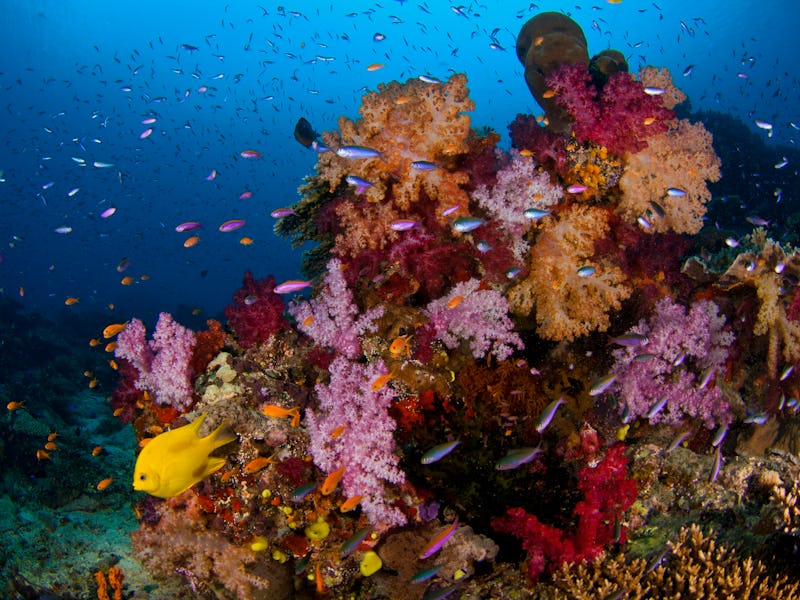Hungry fish in certain areas protect sensitive coral against bleaching
Healthy fish, healthy coral.

The world’s coral reefs are in trouble. Ocean temperatures are rising, bringing mass bleaching events. Now scientists think they understand why this devastating effect happens, shows new research in the journal Science Advances.
In a study published on Wednesday, researchers found that fish seem to be the key ingredient to maintaining healthy, unbleached coral.
Coral reefs in marine protected areas were significantly less susceptible to a pathogen called Vibrio coralliilyticus that causes coral bleaching than corals in unprotected areas. In the MPAs, fishing isn’t allowed, so a rich array of fish munch algae off the reefs. Comparatively, nearby reefs without marine protection were languishing — bleached and covered in algae.
In the study, the team proposes an explanation for why this might be, an explanation that’s supported by their other finding:
They also found that several coral species were better able to defend themselves against infections that cause bleaching when they were in lower-temperature water. And while the connection between water temperatures and protected area designation might not seem obvious, both of these effects seem to come down to chemical defenses that are inhibited by algae growth and kept intact by fish.
This thriving reef in a marine protected area (MPA) had thriving populations of fish munching the algae off the reef.
Previous research has shown that the activity of the corals’ microbiome is a major factor that helps protect it against diseases, writes the team, led by senior author Mark Hay, Ph.D., professor of marine ecology at Georgia Tech.
But in a combination of observations and experiments, Hay and his team showed that chemicals produced by a sensitive and ecologically important coral species, Acropora millepora, also seem to play an important role in its defense against pathogens — defenses that are impeded both by warmer waters and by a lack of protection against overfishing.
Corals in an MPA (a) were thriving, while corals outside of an MPA (b) were covered in algae.
How do marine protected areas help corals?
In several sites near Fiji, researchers collected corals from reefs in MPAs, where fish were plentiful and reefs were colorful, and from reefs outside of MPAs, where overfishing had depleted fish populations and corals were covered in algae. Notably, these sites still had plenty of two other coral species, Porites cylindrica and Pocillopora damicornis, the former which is known to thrive in degraded reefs and the latter which they write is “often one of the first to colonize reefs after disturbances.”
Their observations support the hypothesis that rich fish populations help keep algae trimmed down, in turn letting Acropora species thrive.
“Macroalgae are suggested to disrupt coral microbiomes via transfer of allelochemicals or microbes or release of dissolved organic carbon that affects microbial growth,” they write.
Acropora millepora, a sensitive and ecologically important coral.
How does this affect their response to bacteria?
In the lab, the team took water the corals had been in, sterilized the samples to kill off the microbiomes, and tested how the samples responded to Vibrio coralliilyticus at both 24°C (75.2°F) and 28°C (82.4°F). This yielded several findings:
First, all three of the corals maintained natural defenses against the pathogens, defenses that were still present even without their microbiomes, suggesting that they produce some cocktail of protective immune chemicals.
Second, these defenses were much stronger at the cooler of the two temperatures, which helps explain why warmer waters have been associated with mass bleaching events on coral reefs.
Third, the Acropora samples from the MPAs were better able to fight off the pathogens than those from outside of the MPAs, suggesting that keeping algae at bay helps keep the coral’s defenses strong. Notably, the immunity of Porites and Pocillopora was not affected by living in an MPA or not.
Lastly, they team observed that there were minor but significant microbiome differences between the Acropora from inside and outside the protected zones. Nonetheless, the corals maintained pretty similar microbial communities regardless of algae levels.
Therefore, the team concluded that pathogen-protective chemicals are likely responsible for warding off the bleaching bacteria — and that healthy communities of fish help the corals keep producing such chemicals.
Further research will reveal just what these chemicals are and how they work, perhaps offering clues for saving other reefs. For now, though, one thing is clear: More fish means healthier reefs.
Abstract: Bleaching and disease are decimating coral reefs especially when warming promotes bleaching pathogens, such as Vibrio coralliilyticus. We demonstrate that sterilized washes from three common corals suppress V. coralliilyticus but that this defense is compromised when assays are run at higher temperatures. For a coral within the ecologically critical genus Acropora, inhibition was 75 to 154% greater among colonies from coral-dominated marine protected areas versus adjacent fished areas that were macroalgae-dominated. Acropora microbiomes were more variable within fished areas, suggesting that reef degradation may also perturb coral microbial communities. Defenses of a robust poritid coral and a weedy pocilloporid coral were not affected by reef degradation, and microbiomes were unaltered for these species. For some ecologically critical, but bleaching-susceptible, corals such as Acropora, local management to improve reef state may bolster coral resistance to global change, such as bacteria-induced coral bleaching during warming events.